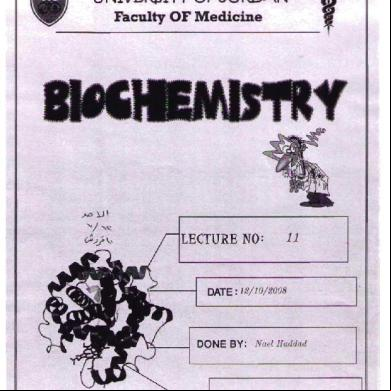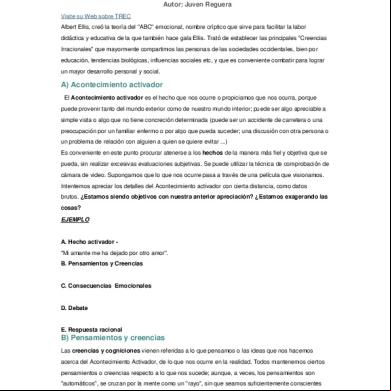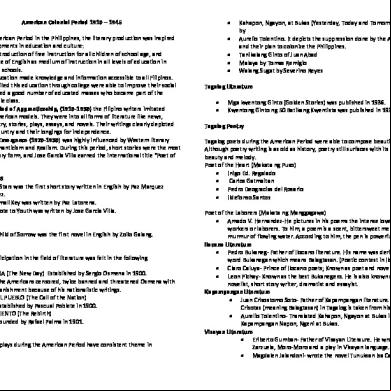Biochem Research 1k1s3v
This document was ed by and they confirmed that they have the permission to share it. If you are author or own the copyright of this book, please report to us by using this report form. Report 3b7i
Overview 3e4r5l
& View Biochem Research as PDF for free.
More details w3441
- Words: 1,029
- Pages: 18
Effects of Agarichus-Blazae Mushroom on Cell Viability on Prostate Cancer Cell Line
Our Lady of Fatima University Biochemistry Department Section E October 7, 2011
OBJECTIVES
General Objective:
- To explore the the biological significance of agarichusblasae to humanity, its benefits for patients suffering from cancer of the prostate.
Specific Objectives:
- To evaluate agarichus-blasae’s possible apoptotic properties against cancer cells. - To observe agarichus-blasae’s biological relation to liver cancer cell prevention and destruction through thorough laboratory sampling and experimentation. - To conceptualize, if not identify credible agarichusblasae’s preparation that will facilitate prostate cancer cell inhibition. - To provide recommendations for the improvement and development of cancer research.
SIGNIFICANCE OF THE STUDY This research does not only contribute in knowledge production in general, but in making breakthroughs as well. The purpose of this research is to gain a better understanding of and/or perspective on Agaricus-Blazae. From its definition, this research will also discuss the sources of Agaricus-Blazae and how does it able to produce apoptotic effects on cancer cells at the same time evaluate the level of its effectiveness being the main focus of the study. This research is especially relevant in the field of Science or specifically in Medicine by contributing and presenting a potential cure for cancer, one of the most fatal diseases in the world. Experts in this field can eventually conduct further studies based on this research on other perspectives as well. Not only exclusive to the field of Medical Sciences, Environmentalists can also benefit from this research by acquiring relevant knowledge, become aware that many of our natural resources are of great value, and be encouraged of their preservation. As for the masses, this research will be very beneficial by providing useful reference for different types of documents.
SIGNIFICANCE OF THE STUDY
The study will be most significant for the people who are in the lower class especially those who are in the undeveloped regions of the country where medical facilities are least available. It is a fact that Philippines, being a third world country, have very limited resources and goods are overpriced including medical expenses. As a result, many people resort in untested, ineffective, alternative medicine in which side-effects could be fatal. By understanding and evaluating carefully, this research will provide and name a potential effective cure for cancer at a low cost because our country has abundant sources of ABM. Aside from being an addition to other potential cures for cancer, this study will also be significant in discouraging people from using untested substances.
WHY AGARICUS? It
is best known mushroom in the western world Originating in Brazil Used for CANCER, type 2 diabetes, high cholesterol, liver disease, blood stream disorders, digestive problems Also used to boost the immune system for physical and emotional stress
WHY AGARICUS? Insufficient
evidence for cancer treatment side effects developing research suggests that taking agaricus mushroom might reduce some effects. Efforts to study the health properties of this tasty mushroom is found to be effective breast cancer inhibitor through animal experiments, but also it is best cancer fighter
WHY AGARICUS? Even
more astounding for those mice fed with mushroom as a preventative agent, injected with powerful cancer-causing Sarcoma 180, 99.4 % of them showed no tumor.
WHY AGARICUS? Most
experiments done are in animals, rarely have cell lines At the Medical department of Tokyo University and Tokyo College of Pharmacy ; mice with cancerous tumors were fed with Agaricus mushroom. The cancerous tumors were eliminated in 90% of the mice.
METHODOLOGY
PLANT EXTRACTION 1. The Agaricus blazae were to be grounded into powder and be dried. 2. Dried powder (100 g) of Agarichus-Blazae was extracted in soxhlet apparatus with 1000 ml of 95% ethanol. The soxhelation process was carried out until the solvent was found to be colorless. 3. The dark brown ethanolic extract was then filtered, concentrated using a rotary evaporator.
METHODOLOGY: EXTRACTION SAMPLE GROUNDED and PULVORIZED
CRUDE EXTRACT
EXTRACTION USING SOXHLET APPARATUS
FILTRATION AND CONCENTRATION
CELL LINE The cell line will be obtained from Saint Luke’s Medical Hospital. The cell will be cultured in a growth medium (pH 7.4) supplemented with 10% Fetal bovine serum (FBS) and antibiotics, penicillin (100 units/ml) and streptomycin sulfate (100 μg/ml).
ANTICANCER ASSAY (MTT Assay)
1. Cells will be seeded into 4 wells of a 96-well micro titer plate at 2 x 104 cells per well with 100 μl growth medium and then incubated for 24 h at 37 °C under 5% CO2. 2. Then the medium will be removed while fresh growth medium containing the agarichus-blasae extract is added at 100, 50 and 25 μg/ml (Dependent variable). Water and (anticancer medicine) for your negative and positive control respectively. 3. After 3 days of incubation at 37 °C under 5% CO2, the medium will be removed while 0.1 mg/ml MTT [3-(4, 5dimethyl thiazole-2yl) - 2, 5-diphenyl tetrazolium bromide] reagent will be added. 4. After 5 h incubation, the MTT will be removed before adding 100 μl DMSO to each well and gently shaken. 5. The absorbance was then determined by ELISA reader at 516 nm. 6. Control wells will receive only the media without the extract.
TEST SAMPLE
INCUBATION WITH AGARICUS (100/50/25 ug/ml) FOR 3 DAYS
MTT ASSAY
POSITIVE CONTROL
NEGATIVE CONTROL
INCUBATION WITH CISPLATIN FOR 3 DAYS
INCUBATION WITH WATER FOR 3 DAYS
MTT ASSAY
MTT ASSAY
ELISA READER 516 NM
APOPTOTIC ASSAY TRYPAN
1. 2. 3.
BLUE ASSAY Centrifuge an aliquot of cell suspension . Resuspend the cell pellet in 1 ml PBS or serum-free complete medium Mix 1 part of 0.4% trypan blue and 1 part cell suspension, allow mixture to incubate ~3 min at room temp
TRYPAN BLUE ASSAY 4. Apply a drop of the trypan blue/cell mixture to a hemacytomer 5. Count the unstained (viable) and stained (nonviable) cells separately.
TIME SCHEDULE March
February
January
December
November
October
September
Finalization of the research proposal
August
July Review of literature / planning Submission and consultation of research proposal
TIME SCHEDULE March
February
January
December
November
October
September
Final Oral Defense
August
July
Experimenta tion time Collection of data Data analysis Finalization of written report
Our Lady of Fatima University Biochemistry Department Section E October 7, 2011
OBJECTIVES
General Objective:
- To explore the the biological significance of agarichusblasae to humanity, its benefits for patients suffering from cancer of the prostate.
Specific Objectives:
- To evaluate agarichus-blasae’s possible apoptotic properties against cancer cells. - To observe agarichus-blasae’s biological relation to liver cancer cell prevention and destruction through thorough laboratory sampling and experimentation. - To conceptualize, if not identify credible agarichusblasae’s preparation that will facilitate prostate cancer cell inhibition. - To provide recommendations for the improvement and development of cancer research.
SIGNIFICANCE OF THE STUDY This research does not only contribute in knowledge production in general, but in making breakthroughs as well. The purpose of this research is to gain a better understanding of and/or perspective on Agaricus-Blazae. From its definition, this research will also discuss the sources of Agaricus-Blazae and how does it able to produce apoptotic effects on cancer cells at the same time evaluate the level of its effectiveness being the main focus of the study. This research is especially relevant in the field of Science or specifically in Medicine by contributing and presenting a potential cure for cancer, one of the most fatal diseases in the world. Experts in this field can eventually conduct further studies based on this research on other perspectives as well. Not only exclusive to the field of Medical Sciences, Environmentalists can also benefit from this research by acquiring relevant knowledge, become aware that many of our natural resources are of great value, and be encouraged of their preservation. As for the masses, this research will be very beneficial by providing useful reference for different types of documents.
SIGNIFICANCE OF THE STUDY
The study will be most significant for the people who are in the lower class especially those who are in the undeveloped regions of the country where medical facilities are least available. It is a fact that Philippines, being a third world country, have very limited resources and goods are overpriced including medical expenses. As a result, many people resort in untested, ineffective, alternative medicine in which side-effects could be fatal. By understanding and evaluating carefully, this research will provide and name a potential effective cure for cancer at a low cost because our country has abundant sources of ABM. Aside from being an addition to other potential cures for cancer, this study will also be significant in discouraging people from using untested substances.
WHY AGARICUS? It
is best known mushroom in the western world Originating in Brazil Used for CANCER, type 2 diabetes, high cholesterol, liver disease, blood stream disorders, digestive problems Also used to boost the immune system for physical and emotional stress
WHY AGARICUS? Insufficient
evidence for cancer treatment side effects developing research suggests that taking agaricus mushroom might reduce some effects. Efforts to study the health properties of this tasty mushroom is found to be effective breast cancer inhibitor through animal experiments, but also it is best cancer fighter
WHY AGARICUS? Even
more astounding for those mice fed with mushroom as a preventative agent, injected with powerful cancer-causing Sarcoma 180, 99.4 % of them showed no tumor.
WHY AGARICUS? Most
experiments done are in animals, rarely have cell lines At the Medical department of Tokyo University and Tokyo College of Pharmacy ; mice with cancerous tumors were fed with Agaricus mushroom. The cancerous tumors were eliminated in 90% of the mice.
METHODOLOGY
PLANT EXTRACTION 1. The Agaricus blazae were to be grounded into powder and be dried. 2. Dried powder (100 g) of Agarichus-Blazae was extracted in soxhlet apparatus with 1000 ml of 95% ethanol. The soxhelation process was carried out until the solvent was found to be colorless. 3. The dark brown ethanolic extract was then filtered, concentrated using a rotary evaporator.
METHODOLOGY: EXTRACTION SAMPLE GROUNDED and PULVORIZED
CRUDE EXTRACT
EXTRACTION USING SOXHLET APPARATUS
FILTRATION AND CONCENTRATION
CELL LINE The cell line will be obtained from Saint Luke’s Medical Hospital. The cell will be cultured in a growth medium (pH 7.4) supplemented with 10% Fetal bovine serum (FBS) and antibiotics, penicillin (100 units/ml) and streptomycin sulfate (100 μg/ml).
ANTICANCER ASSAY (MTT Assay)
1. Cells will be seeded into 4 wells of a 96-well micro titer plate at 2 x 104 cells per well with 100 μl growth medium and then incubated for 24 h at 37 °C under 5% CO2. 2. Then the medium will be removed while fresh growth medium containing the agarichus-blasae extract is added at 100, 50 and 25 μg/ml (Dependent variable). Water and (anticancer medicine) for your negative and positive control respectively. 3. After 3 days of incubation at 37 °C under 5% CO2, the medium will be removed while 0.1 mg/ml MTT [3-(4, 5dimethyl thiazole-2yl) - 2, 5-diphenyl tetrazolium bromide] reagent will be added. 4. After 5 h incubation, the MTT will be removed before adding 100 μl DMSO to each well and gently shaken. 5. The absorbance was then determined by ELISA reader at 516 nm. 6. Control wells will receive only the media without the extract.
TEST SAMPLE
INCUBATION WITH AGARICUS (100/50/25 ug/ml) FOR 3 DAYS
MTT ASSAY
POSITIVE CONTROL
NEGATIVE CONTROL
INCUBATION WITH CISPLATIN FOR 3 DAYS
INCUBATION WITH WATER FOR 3 DAYS
MTT ASSAY
MTT ASSAY
ELISA READER 516 NM
APOPTOTIC ASSAY TRYPAN
1. 2. 3.
BLUE ASSAY Centrifuge an aliquot of cell suspension . Resuspend the cell pellet in 1 ml PBS or serum-free complete medium Mix 1 part of 0.4% trypan blue and 1 part cell suspension, allow mixture to incubate ~3 min at room temp
TRYPAN BLUE ASSAY 4. Apply a drop of the trypan blue/cell mixture to a hemacytomer 5. Count the unstained (viable) and stained (nonviable) cells separately.
TIME SCHEDULE March
February
January
December
November
October
September
Finalization of the research proposal
August
July Review of literature / planning Submission and consultation of research proposal
TIME SCHEDULE March
February
January
December
November
October
September
Final Oral Defense
August
July
Experimenta tion time Collection of data Data analysis Finalization of written report










